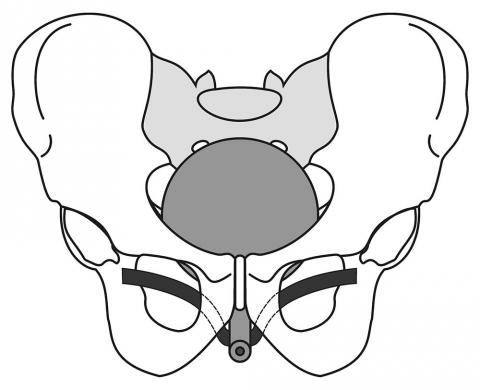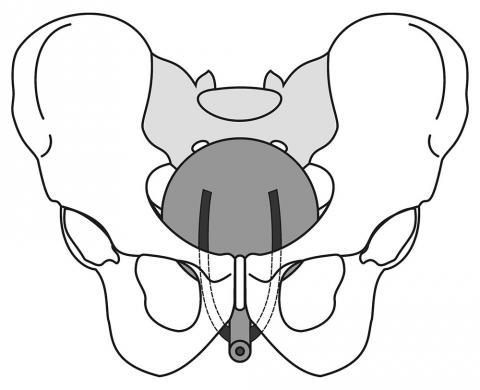Sling surgery for stress urinary incontinence is best deferred until a woman has completed her family as further pregnancies and childbirth can reverse the effects of surgery and result in recurrent stress incontinence.
What is a Mid-Urethral Sling (MUS)?
A mid-urethral sling is a thin ribbon of material that lies under the middle section of the urethra (the tube draining the urine from the bladder). The sling acts by providing support under the urethra when there is a rise in intra-abdominal pressure (e.g. with cough, exercise, lifting) to help prevent stress incontinence.
What are the different types of Mid-Urethral Slings?
There are 2 main types of mid-urethral slings: retropubic and transobturator slings. Under anaesthesia a small incision is made in the vagina over the urethra and the sling can be inserted into position in different ways:
- Retropubic slings – pass underneath the middle of the urethra and then run behind the pubic bone (in front of the bladder). Retropubic slings exit through 2 small cuts in the skin just above the pubic bone (below the pubic hairline).
- Transobturator slings – pass underneath the middle of the urethra and exit the skin through 2 small cuts in the inner groin / top of the thigh area.
- A 3rd type of sling is known as a “mini-sling” or single-incision sling because there is no exit site of the sling through the skin. This sling is inserted through a single incision in the vagina. There is less long term information available regarding the results of mini-slings as they have not been as extensively studied as retropubic and transobturator slings.
- The sling is not stitched in but stays in position by itself.
Mid-urethral slings are made of a small strip of medical mesh (polypropylene) similar to the material used in other surgery such as hernia repairs. The mid-urethral sling material remains in the body permanently (i.e. it is not absorbed over time).

Diagram of a Transobturator mid-urethral sling to treat stress urinary incontinence.
Copyright Dr Karen McKertich - Not for use without attribution.

Diagram of a Retropubic mid-urethral sling to treat stress urinary incontinence.
Copyright Dr Karen McKertich - Not for use without attribution.
What does the procedure involve?
Mid-urethral sling surgery is performed as a day case or overnight stay in hospital under a general anaesthetic. The procedure is combined with a cystoscopy to confirm correct sling placement.
If the patient passes urine well after removal of the catheter (urinary drainage tube) after the procedure, they can go home.
Restriction in activity is required for at least 4 to 6 weeks after surgery to allow the sling to scar into position and maximise the success of surgery.
How successful are Mid-Urethral Slings in treating Stress Urinary Incontinence in Women?
Synthetic mid-urethral slings are the most studied surgery to treat stress urinary incontinence with over 2000 journal articles published regarding the results of slings. Large studies have shown mid-urethral slings to have a high success rate and low complication rate with durable effects.
Retropubic and transobturator mid-urethral slings cure or significantly improve stress urinary incontinence in 80 to 90% of women.
How long have Mid-Urethral Slings been used?
The retropubic mid-urethral sling (TVT® sling) was introduced in 1996. Seventeen year follow up of the original group of women undergoing surgery with the TVT® sling reported that the TVT® operation was durable over 17 years with a high satisfaction rate and no serious long-term sling related problems.
Are Mid-Urethral Slings safe?
Mid-urethral slings are considered to be safe and effective in the treatment of stress urinary incontinence. Studies have shown them to be as effective as the older more traditional forms of stress incontinence surgery (e.g. Burch colposuspension and pubovaginal fascial tissues slings). Mid-urethral slings have the advantage over these types of surgery of being minimally invasive which results in a shorter stay in hospital and faster recovery time.
What are the potential side effects of Mid-Urethral Sling surgery for Stress Incontinence?
All surgery for stress urinary incontinence has potential side effects.
Specific risks associated with mid-urethral sling surgery include:
- Failure to improve or rarely worsening of stress urinary incontinence
- Development of new overactive bladder (OAB) symptoms or worsening of pre-existing OAB symptoms
- Damage to nearby structures on insertion of the sling such as the bladder, urethra, blood vessels or bowel
- Difficulty in urination which may result in a need to loosen or divide the sling
- Urinary tract infection
- Wound infection
- Small risk of pain in the inner thigh with a transobturator sling
- Small risk of problems related to the use of synthetic material e.g. erosion or exposure of the sling in the vagina or rarely urethra or bladder
- Discomfort related to sexual intercourse
Are there other alternatives to treat Stress Urinary Incontinence in Women?
Many treatment options exist for women with stress urinary incontinence, including:
- Pelvic floor physiotherapy
- Weight loss if overweight
- Continence devices used vaginally
- Sling surgery with fascial or natural tissues slings
- Injectable agents
- Colposuspension
What is the difference between a Mid-Urethral Sling and Vaginal Prolapse Mesh?
A mid-urethral sling is used to treat stress urinary incontinence and is a very small ribbon of mesh material placed underneath the urethra.
Vaginal prolapse mesh is used to treat a vaginal bulge or prolapse and is not used to treat incontinence.
Vaginal prolapse mesh is larger and placed in a different location to the mid-urethral sling mesh used for stress urinary incontinence.
There is considerable debate about the use and place of vaginal mesh in the treatment of vaginal prolapse due to the increased rate of problems when mesh is used to treat vaginal prolapse. The use of mid-urethral slings in the treatment of stress urinary incontinence has, however, been established to be safe, effective and durable.
Frequently Asked Questions by Patients - Mid-urethral Slings for Stress Urinary Incontinence
Position Statement on Mesh Midurethral Slings for Stress Urinary Incontinence
Position Statement on Mid-Urethral Slings for Stress Urinary Incontinence





